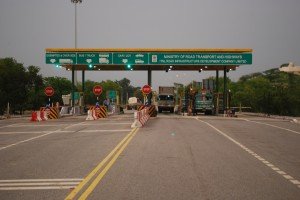ITNL Case Study: Beawar-Gomti Road Project
The Beawar-Gomti Road Project comprises the development and operation of the National Highway-8 from Km 58+245 to Km 177+050 on Design, Build, Finance, Operate and Transfer (DBFOT) basis. The project road is owned by the Ministry of Road Transport & Highways (MoRTH)
This project road has two toll plazas located at Km 84+220 and Km 133+500 with six lanes each, inclusive of an Extra Wide Lane in each direction for over-dimensional vehicles. All the lanes have been installed with Semi-Automatic Toll Collection Systems with fully integrated Weigh-In-Motion (WIM) Systems
 This Toll Management System has been developed fully in-house by ITNL (IL&FS’s Transport Networks Limited) and is one of a kind as this is one of the first toll plazas in India to have a Toll Management System which is fully integrated with pre-processing type slow speed WIM system. This enables the toll collector to not only collect toll for the vehicles being processed, but also to detect and collect additional toll for overloaded vehicles seamlessly.
This Toll Management System has been developed fully in-house by ITNL (IL&FS’s Transport Networks Limited) and is one of a kind as this is one of the first toll plazas in India to have a Toll Management System which is fully integrated with pre-processing type slow speed WIM system. This enables the toll collector to not only collect toll for the vehicles being processed, but also to detect and collect additional toll for overloaded vehicles seamlessly.
The salient features of the toll collection system in place here are as under:
• Computerised Toll Collection and generation of receipts for fool proof recording and audit of all transactions and toll fee collected.
• Fully integrated automatic lane peripherals like Automatic Boom Barriers, Traffic Lights, Over Head Lane Signs, User Fare Display, Violation Alarms, etc., for efficient segregation of vehicles and traffic management at the toll plaza.
• Integrated Pre-Processing Weigh-In-Motion Systems in which the weight of the vehicle approaching the toll booth is automatically detected without the vehicle having to stop. This weight is displayed on the Toll Collector’s Computer and appropriate toll receipts are generated automatically if the vehicle is overloaded.
• Automatic Vehicle Classification System with Incident Capturing for detection of any traffic violations or misclassifications by the toll collector.
• CCTV Surveillance Cameras located in the toll lanes, booths, cashier rooms and admin buildings for 24 X 7 surveillance and security.
• Various MIS Reports can be generated from the system based on the requirements of MoRTH and the company.
Toll leakage is one of the major problems for all the Concessionaires or BOT operators. However, with an effective toll management system and ITNL’s past experience, this problem has been managed quite effectively. Toll leakages occur mainly through misappropriation of cash by the toll collectors, by under classification of vehicles, processing of non-exempted vehicles under the exempt category and non-payment of user fee by local vehicles.
These leakages are controlled using various aspects of the Toll Management System: Automatic boom barriers are installed at each toll lane which are integrated with the toll collection system so as to prevent a run-through of the vehicles; under classification of the vehicle is controlled quite effectively by implementation of the AVC and Incident Capturing System which automatically detects and records any such misappropriation. In addition, sensors for slow speed weigh-motion system have been installed just before the entry in the toll lane and the combination of data from AVC and WIM is used to stop any instances of under classification by toll collectors.
Biometric access control systems are installed in control rooms, server rooms and cash-up rooms to prevent unauthorised access in restricted areas. Toll Leakages are further controlled by the CCTV surveillance system which is also integrated with the toll management system.
By introducing of schemes for local and frequent users, over and above to what has been specified in toll notification, the local users are attracted to pay and pass through the toll plaza. This, in turn, minimises the non-payment by local users. These kinds of schemes can later be implemented using Smart Card Payment Methods the provision for which is already integrated in the existing Toll Management System.
The implementation of a proper and robust toll management system means that all transactions conducted are auditable, secure and verifiable. The implementation of such an MIS leads to much easy and fast reporting of Traffic and Collection Figures which can easily be used for various activities like financial projections, traffic analysis, traffic forecasting, etc.
 Jigish Vora
Senior Manager, IL&FS
Jigish Vora
Senior Manager, IL&FS
 TrafficInfraTech Magazine Linking People Places & Progress
TrafficInfraTech Magazine Linking People Places & Progress